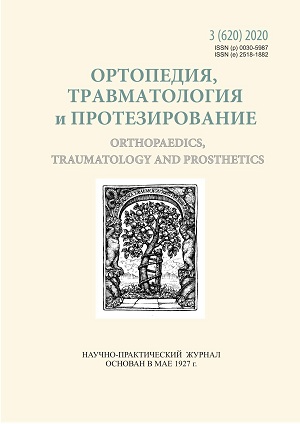Macro- and microelement content of intervertebral discs in hernias of the lumbar spine
DOI:
https://doi.org/10.15674/0030-59872020329-35Keywords:
lumbar spine disease, intervertebral disc herniation, neutron activation analysis, microelementsAbstract
Studies of the mechanisms of lumbar spine disease are relevant, as the choice of adequate treatment requires in-depth knowledge of the its etiopathogenesis changes in the spine tissues. The macro- and microelement content of intervertebral disc herniation (IDH) are least studied. Objective: to assess changes in the element composition of intervertebral disc herniation at conditions of degree of degeneration. Methods: using instrumental neutron activation analysis (INAA) we studied biomaterial obtained during microdiscectomy at LIII–LIV, LIV–LV, LV–SI spine levels. Group A — 8 fragments of hernias from patients aged 24–36 years with structural changes of intervertebral discs, group B — 7 fragments from patients at the age of 37–44 years with total degeneration of the spinal motor segments, group B — 7 samples from patients aged 45–60 years with degenerative deformities of the spine. INAA allowed to outline the content of 22 essential trace elements. The maximum error of the activation method for determining the elements did not exceed 12 %. Results: it was found a gradual change in the content of certain essential elements depending on the stage of the destructive process in intervertebral discs tissues. In particular, changes in sodium, potassium, chlorine leads to contravention of acid-base balance in the tissues, reducing the iron content by 1.44 times — to reduce the flow of oxygen to the intervertebral disc. At the same time, the reduction of calcium levels at the beginning of the degenerative process by 2 times, and then its increase by 1.6 times indicates on calcification of the intervertebral soft tissues. Conclusions: microelement correlations in intervertebral discs tissues are established and the course of the degenerative process can be used to predict the patient’s condition and the choice of adequate treatment.References
- Korzh, N. A., Prodan, A. I., & Barysh, A. E. (2004). Degenerative diseases of the spine and their structural and functional classification. Ukrainian neurosurgical journal, 3, 27–30. [in Russian]
- Urban, J. P., & Roberts, S. (2003). Degeneration of the intervertebral disc. Arthritis Research & Therapy, 5(3), 120–130. doi: 10.1186/ar629
- Prodan, A. I., Radchenko, V. A., & Korzh, N. A. (2007). Degenerative diseases of the spine. Kharkiv. [in Russian]
- Fardon, D. F., Williams, A. L., Dohring, E. J., Murtagh, F. R., Gabriel Rothman, S. L., & Sze, G. K. (2014). Lumbar disc nomenclature: Version 2.0. The Spine Journal, 14(11), 2525-2545. doi: 10.1016/j.spinee.2014.04.022
- Vasilyeva, I. G., Khizhnyak, M. V., Shuba, I. N., & Gafiychuk, Yu. G. (2010). Degeneration of intervertebral discs and methods of its biological correction. Ukrainian Neurosurgical Journal, 1, 16–23. doi: 10.25305/unj.88759. [in Russian]
- Zaydman, A. M., & Filippova, G. N. (1980). Structural and metabolic features of the intervertebral disc in osteochondrosis and the possibility of its correction. Pathology of the spine, St. Petersburg. [in Russian]
- Shapiro, I. M., & Risbud, M. V. (2014). The intervertebral disc. Molecular and structural studies of the disc in health and disease. Springer-Verlag Wien. doi: 10.1007/978-3-7091-1535-0
- Byvaltsev, V., Belykh, E., Panasenkov, S., Ivanov, N., Tsyganov, P., & V. Sorokovikov. (2012). Nanostructural changes of intervertebral disc after diode laser ablation. World Neurosurgery, Vol. 77(1), 6–7. doi: 10.1016/j.wneu.2011.11.001.
- Gumienna-Kontecka, E., Rowińska-Żyrek, M., & Łuczkowski, M. (2018). The role of trace elements in living organisms. Recent Advances in Trace Elements, 177-206. doi: 10.1002/9781119133780.ch9
- Nеve, J., Chappuis, P., & Lamand, M. (1996). Therapeutic uses of trace elements. Springer US. doi: 10.1007/978-1-4899-0167-5
- Danilova, E. A., Kist, A. A., Osinskaya, N. S., & Khusniddinova, S. Kh. (2008). Application of neutron activation analysis to assess the elemental status of the human body. Medical Physics, 3, 73–77. [in Russian]
- Skalny, A. V., & Rudakov, I. A. (2004). Bioelements in medicine. Moscow, Onyx 21st century. [in Russian]
- Piontkovsky, V. K. (2019). Pathogenesis, diagnosis and surgical treatment of lumbar intervertebral disc herniation in elderly and senile patients: dissertation of Doctor in Medical Sciences. Kharkiv. [in Ukrainian]
- Mednis, I. V. (1987). Gamma radiation of radionuclides used in neutron activation analysis. Reference. Riga: Zinatne. [in Russian]
Downloads
How to Cite
Issue
Section
License
Copyright (c) 2020 Sanjar Kochkartaev, Shahaidar Shatursunov, Elena Danilova, Natalija Osinskaya

This work is licensed under a Creative Commons Attribution 4.0 International License.
The authors retain the right of authorship of their manuscript and pass the journal the right of the first publication of this article, which automatically become available from the date of publication under the terms of Creative Commons Attribution License, which allows others to freely distribute the published manuscript with mandatory linking to authors of the original research and the first publication of this one in this journal.
Authors have the right to enter into a separate supplemental agreement on the additional non-exclusive distribution of manuscript in the form in which it was published by the journal (i.e. to put work in electronic storage of an institution or publish as a part of the book) while maintaining the reference to the first publication of the manuscript in this journal.
The editorial policy of the journal allows authors and encourages manuscript accommodation online (i.e. in storage of an institution or on the personal websites) as before submission of the manuscript to the editorial office, and during its editorial processing because it contributes to productive scientific discussion and positively affects the efficiency and dynamics of the published manuscript citation (see The Effect of Open Access).














